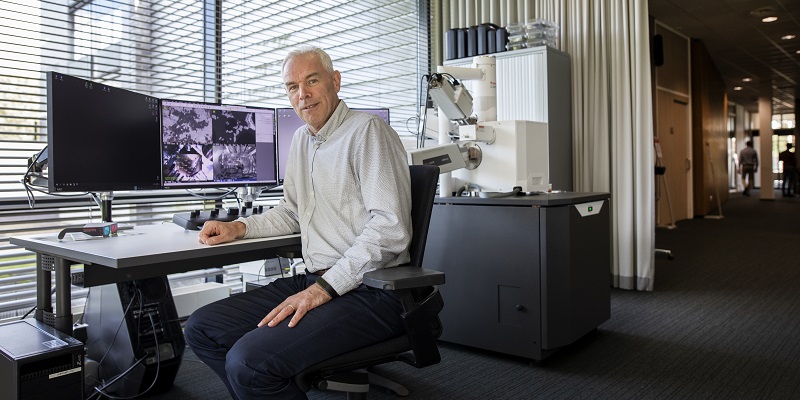Reinier Perquin - Thermo Fisher
In the midst of a tight Dutch labor market, companies are working harder than ever to keep and attract new talent. Thermo Fisher software manager Reinier Perquin believes that providing his employees with training opportunities not only helps bring in new personnel, but it also keeps his people fresh. He organized the ‘Design patterns and emergent architecture‘ training for his team.
Thermo Fisher Scientific, a multinational leader in biotechnology product development, employs more than 70,000 people around the world. But how does a company, with such a large global footprint, manage to keep its workers and continually draw in new employees? According to the software group manager from Thermo Fisher’s Eindhoven offices, Reinier Perquin, the main attraction for engineers is the opportunity to work on cutting-edge projects. An example: using advanced software to help solve the problem of global diseases. To get these talented engineers on board, Perquin says investment in training – both technical and social – is a valuable tool.
'Training budgets are increasingly important to attracting prospective colleagues.'
As a manager within the Thermo Fisher R&D department in Eindhoven, Perquin is routinely interviewing to bring new faces to the software group. What he’s noticed in these meetings: training budgets are increasingly important to attracting prospective colleagues. “In some interviews, it’s one of the first questions that people will ask. We’re seeing that more and more. While we don’t offer individual training budgets, we understand how important it can be, so we have a group budget specifically to encourage our employees to utilize training opportunities,” explains Perquin.

Photo by Vincent van den Hoogen.
Do you prefer internal or external training?
“We offer both to our employees but getting an outside view can be very helpful and that’s why we encourage external training. Our workers can gain new insights and learn about emerging technologies and cutting-edge methods. In my department, we’re seeing that the whole architecture of software is evolving before our eyes. Before, it was closed off but now you see things happening in the cloud or edge computing. That happens because new technology enables that. In software, you must constantly learn and adjust. So, if you don’t invest in yourself, then, in the end, you stand still. These trainings are a great method to enhance skills and learn about novel solutions.”
The ‘Design patterns and emergent architecture’ training took place in-company.
What’s the greatest benefit of offering your employees training?
“Well, first of all, people are really busy with their day-to-day tasks. Sometimes it’s good to step outside and take a break from thinking only about your work. It gives people the opportunity to not only get a break from their daily challenges but to focus on enhancing their personal skill set,” describes Perquin. “Also, it gives our engineers the opportunity to meet people from other companies and build a social and professional network. If people sit still too long without training – especially externally – they start to think in certain ways within their comfort zones. For some problems, you need to think outside of the box – not in absolutes like, ‘We’ve always done it like this, so we’ll continue to do this like this’. That’s the wrong mentality. Trainings help to disrupt this way of thinking.”
What type of courses are your workers choosing?
“Being in software, we often see our employees opting for training in design patterns in emergent architecture, taught by Onno van Roosmalen at High Tech Institute. In software, you see a repetition of certain patterns. By giving these patterns common names, essentially creating a unified software language, our engineers can better communicate and solve problems. Onno and I have a long history, going back to university, so I know the level of the knowledge that’s being taught and that training is easy to approve for our employees.”
Are there any other trainings you utilize?
“To be honest, we probably spend most of our budget on the soft-skills training – probably more than the technical trainings. Sometimes when people come straight from university, they tend to think that they know everything. Technically, these people can be very strong but often their soft skills are their weakest spot. Everyone wants to believe they’re system architects but I always say, an architect is not a technical person. In that situation, soft skills are more important than the whole technical level. If you already know everything, how will you ever learn something new? Sometimes they don’t realize it and they need time for reflection. That’s something the soft-skills training is incredibly helpful with.”
Do you notice a return on your investment? Does it help output?
“Absolutely. I don’t see it as we’re losing three days of work; I see it as a worthwhile investment, both for the company and for the individual. I believe it helps in terms of productivity, especially the soft skills. We see very positive changes because people realize that if they want to achieve something, they may need to adopt a different approach. We see that trainees come back communicating ideas more clearly and working better with people and it makes them a far more effective employee. We find that our colleagues come back with new ideas, new energy and new inspiration. It keeps people fresh.”
This article is written by Collin Arocho, tech editor of Bits&Chips.
Recommendation by former participants
By the end of the training participants are asked to fill out an evaluation form. To the question: 'Would you recommend this training to others?' they responded with a 8.8 out of 10.

